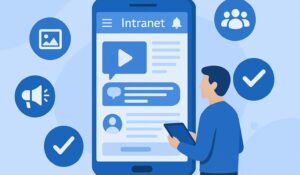Finding the right intranet provider is no longer just about picking a piece of software—it’s about selecting a long-term partner that will help your organization improve communication, connect employees, and streamline work. A provider delivers more than just technology; they offer services, onboarding, integrations, and ongoing support that determine whether your intranet will actually be adopted and deliver ROI.
The challenge? With dozens of intranet vendors and intranet solution providers available—each with different pricing, features, and focus areas—it can be overwhelming to choose the best fit. In this guide, we’ll break down what makes a great intranet provider, compare the top intranet providers of 2025, share real-world examples, and give you practical evaluation tips.
👉 For a broader view of intranet platforms and how they transform organizations, explore our intranet software guide.
What Makes a Great Intranet Solution Provider?
Not all intranet solution providers are created equal. Beyond features, the true difference comes down to the experience they deliver. Here are the key factors to look for when evaluating options:
- Customer Support & Service – Does the provider offer hands-on onboarding, training, and fast support? Adoption fails without strong guidance.
- Integrations – A good intranet should connect seamlessly with tools you already use—HRIS, payroll, Microsoft 365, Google Workspace, Slack, Teams, and more.
- Scalability – Can the intranet grow with you, whether you’re a 500-person company or a 50,000-employee enterprise?
- Employee Engagement Tools – Modern intranets must go beyond static pages. Look for surveys, recognition, social features, gamification, and push notifications.
- Security & Compliance – Critical for regulated industries. Ensure role-based permissions, SSO, and audit capabilities are included.
👉 Dive deeper into how intranets support organizational needs in our company intranet software guide.
Top Intranet Providers in 2025
To help you cut through the noise, here’s an overview of the best intranet vendors in 2025. Each one has its strengths, but not all are right for every business.
HubEngage (Recommended Provider)
HubEngage stands out as a unified, engagement-first intranet platform that combines communications, recognition, surveys, social networking, and AI-powered chatbots—all in one app. Unlike providers that focus on just content management, HubEngage emphasizes employee adoption with gamification, personalization, and multi-channel delivery (mobile app, desktop, email, Teams, Slack, SMS, and digital signage).
✅ Why choose HubEngage?
- Unified Platform – One solution for communications, recognition, surveys, social, and AI.
- Engagement-First Design – Gamification, push notifications, and personalization.
- Multi-Channel Reach – Mobile, desktop, email, chat, signage, SMS.
- Scalable – Works for SMBs and large enterprises alike.
👉 Explore the full platform here: HubEngage Employee Intranet.
Comparison of Top Intranet Vendors in 2025
| Provider | Best For | Strengths | Weaknesses |
|---|---|---|---|
| HubEngage | Organizations of all sizes seeking engagement-first intranet | Unified platform, multi-channel, gamification, AI chatbot, customizable hubs | Newer brand recognition compared to legacy vendors |
| Workvivo | Culture-driven companies, part of Zoom ecosystem | Strong focus on employee experience, social intranet feel | Limited customization, better for mid-sized firms |
| Staffbase | Large enterprises & frontline workforce | Strong mobile intranet, branded apps, strong communication features | Can be complex/expensive for SMBs |
| Simpplr | Mid-to-large enterprises needing governance | AI-driven search, strong content governance | More expensive than competitors |
| Unily | Enterprises with global reach | Highly customizable, strong enterprise features | Higher cost, longer implementation |
| Firstup | Large enterprises prioritizing top-down comms | Strong broadcast & automation tools | Less focus on social/peer-to-peer engagement |
| Interact | SMBs to enterprises with SharePoint alternative needs | Intuitive UI, social features, analytics | Customization limited compared to others |
| Axero | Mid-market companies wanting affordable intranet | Cost-effective, all-in-one approach | Fewer advanced enterprise features |
How to Evaluate Intranet Solution Providers
Choosing the right intranet vendor means looking beyond the sales pitch. Here’s a practical evaluation checklist:
- Ease of Implementation – How quickly can it be deployed? Is IT required or can comms teams self-manage?
- Pricing Transparency – Per-user vs. license vs. tiered pricing. Hidden costs can add up.
- Mobile User Experience – Especially important for frontline and deskless employees.
- Analytics & Reporting – Engagement dashboards, content performance, and employee insights.
- Integration Ecosystem – Does it plug into HR, payroll, and collaboration tools you already use?
- Data Security – Check for multi-tenant separation, encryption, hosting details, ownership rights, and certifications like SOC 2, ISO 27001, HIPAA, GDPR, and DPA compliance.
- Support + Consultation – Ensure the provider includes training, ongoing support, and proactive consultation. HubEngage, for example, offers monthly meetings to review metrics and share best practices to boost engagement.
👉 For a curated list of top intranet platforms, check our best intranet software platforms.
Real-World Examples of Intranet Providers in Action
- Global Enterprise: A Fortune 500 manufacturer rolled out HubEngage to connect 30,000 employees across 15 countries. With multilingual intranet features, they unified communications across corporate HQ and frontline teams.
- Frontline Workforce: A hotel chain used HubEngage’s mobile-first intranet to reach 5,000 staff across 700+ locations. Employees can now access updates, policies, and recognition tools directly from their phones.
- Regulated Industry: A healthcare provider implemented HubEngage to centralize SOPs, policies, and compliance updates. Role-based access and audit trails ensured security while keeping staff informed.
👉 Explore more engagement examples in our guide to employee engagement activities and ideas.
Intranet Provider Pricing Models
Pricing structures vary across intranet solution providers:
- Per-User Pricing – Most common, ideal for scaling but costs rise with headcount.
- Flat License Fee – Good for smaller companies with predictable usage.
- Tiered Plans – Feature-based packages (e.g., basic comms vs. advanced analytics).
When reviewing pricing, always examine the Service Level Agreement (SLA). Look for uptime guarantees (99.9%+), support response times, and data residency policies. Just as important, make sure customer training and service are clearly included in your package. Many intranet providers will promote low software fees upfront, only to charge extra for every support request, content update, or configuration change—costs that can quickly add up.
This is where HubEngage takes a different approach. We don’t nickel-and-dime customers for every interaction. Instead, HubEngage includes comprehensive support, training, and free monthly engagement consultancy in every plan. Our team actively monitors engagement metrics, provides best-practice guidance, and delivers tailored recommendations to help organizations get the most out of their intranet investment—without hidden fees.
Data Security Considerations When Choosing an Intranet Provider
Security is one of the most critical factors when evaluating intranet vendors or solution providers. With SaaS platforms, your company data is often stored alongside other customers’ data in multi-tenant systems. This can create risks if not designed properly. The best providers ensure clean separation of data by encrypting each customer’s information separately and using secure tenant isolation so no data can be accidentally accessed across clients.
You’ll also want to ask where the data is hosted. Leading vendors should provide clear details on their hosting regions and allow for data residency requirements when needed. Equally important is data ownership. Even if your contract ends, you should retain ownership of your company data and have the ability to export or transfer it back at no additional cost.
When assessing providers, confirm that they meet key certifications and compliance standards such as SOC 2, ISO 27001, HIPAA, GDPR, and provide a Data Processing Agreement (DPA). These demonstrate that the provider has undergone rigorous audits and adheres to global best practices in data security and privacy.
Finally, consider AI-related security practices. If the intranet provider offers AI assistants or chatbots, ensure that your employee and company data is not being used to train external models. The best providers isolate AI functionality within secure environments, keeping your data private while still delivering the benefits of automation and intelligent assistance.
Conclusion: Find the Intranet Provider That Fits Your Business
The right intranet provider can transform your organization—driving engagement, cutting costs, and making communication seamless. As you evaluate vendors, weigh both technology and services, and always consider employee adoption.
For organizations seeking an all-in-one, scalable, engagement-first solution, HubEngage consistently ranks among the top intranet providers in 2025.
👉 See why leading organizations choose us: Book a HubEngage Demo.
FAQs
What is an intranet provider?
An intranet provider delivers both the software and the services needed to implement and manage an internal company network. Unlike software-only vendors, providers guide you through adoption, integrations, and ongoing support.
How do providers differ from software-only vendors?
Software vendors typically offer just the platform. Intranet solution providers combine technology with professional services—onboarding, training, integrations, and customer success programs.
Which intranet provider is best for SMBs vs enterprises?
- SMBs benefit from affordable, easy-to-implement intranets like HubEngage or Axero.
- Enterprises often choose providers like Staffbase, Simpplr, or Unily for global scalability and governance.
What services should a good intranet provider offer?
Key services include onboarding, training, 24/7 customer support, content migration, custom integrations, and analytics guidance.
How much does an intranet provider cost?
Pricing varies by provider, typically ranging from $2–$7 per employee per month depending on modules and features selected. For example, HubEngage pricing falls in this range, with flexibility to scale as organizations add capabilities.
What data security questions should I ask an intranet provider?
Ask where the data is hosted, how it is encrypted, whether data is stored separately in a multi-tenant environment, and who owns the data. Ensure you have rights to export your data if the contract ends. Verify compliance with certifications like SOC 2, ISO 27001, HIPAA, GDPR, and that a Data Processing Agreement (DPA) is provided.













